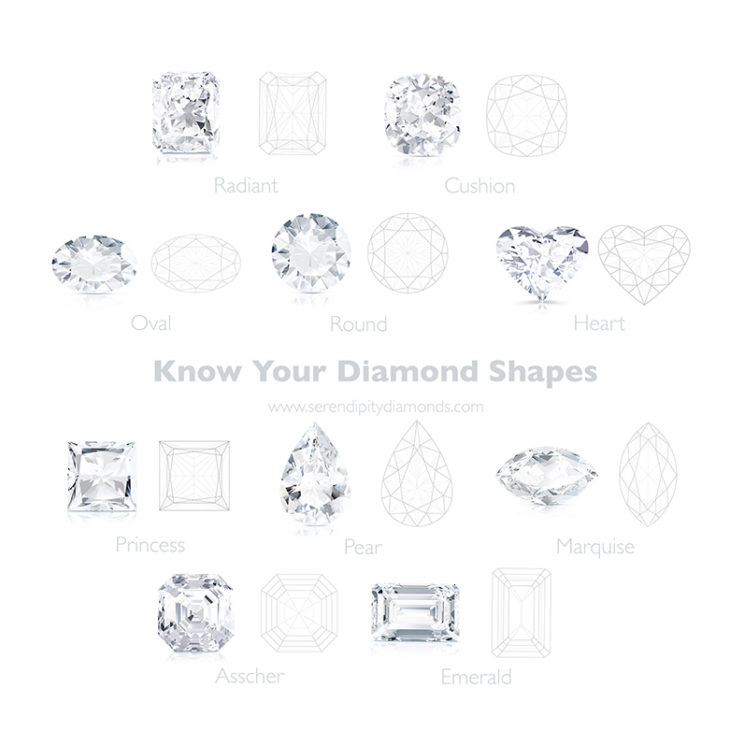A quick guide to fancy diamond shapes
We have included below some guidance on fancy diamond shapes. The following information comes from our extensive diamond information pages which cover many topics from diamond colour to diamond clarity.
Our diamond shapes information covers the following guidance, with additional images of each of the cuts.
Although many more shapes exist, these are the more popular cuts that buyers choose for engagement rings.
Round Brilliant-Cut Diamonds
The round brilliant cut diamond is by far the most popular of all the polished diamond shapes. It consists of 57 facets (or 58 if a culet is present). While the facet count is standard, the actual proportions (crown height and angle, pavilion depth) can vary depending on how the diamond is cut. The round brilliant cut diamond lends itself to many different ring styles and is a particularly versatile diamond shape.
Princess cut Diamonds
The princess cut is a brilliant-style shape with sharp uncut corners. It was developed in 1980 by Betsalel Ambar and Israel Atzkowitz of Ambar Diamonds. A princess cut generally has 76 facets giving it more brilliance and fire than a round brilliant. The princess cut diamond is one of the most popular square cuts of diamond along with the round brilliant cut.
Emerald Cut Diamonds are rectangular step cut diamonds with diagonally cut corners and two, three or four rows of facets, parallel to the girdle on the crown and pavilion. The look of an emerald cut diamond is subtle. The proportion of an emerald cut is typically a length measuring approximately 1.5-1.75 times the width, although variations are common.
Oval cut diamonds are brilliant cut with an elliptical girdle outline. It is also called an oval brilliant cut. It often appears larger than a round stone of the same weight. It was created in the 1960’s by Lazare Kaplan. A length to width ratio of 1.5:1 is a typical pleasing shape. Typically these stones have 56 facets.
The marquise shape is an elongated boat-shaped brilliant cut with curving sides and pointed ends. It was developed in France in the 1740’s. It was supposedly named after King Louis XIV desired a stone to be polished into the shape of the mouth of the Marquise de Pompadour. This shape is also sometimes named Navette. Proportions vary, but a typical ratio is 1.85: 1 to 2:1. The typical marquise shape contains 56 facets.
The Heart Shape is a modified brilliant cut in the shape of a heart. Also known as a Heart Shaped Modified Brilliant. It has a crown shaped table and typically has 59 facets. The heart shape diamond is perhaps the most romantic of all the fancy cuts. The length to width ratio is normally 1:1 but as with many shapes, variations are often found.
The Pear Shape Diamond is a variant of the brilliant cut. Also referred to as a Pear Shaped Modified Brilliant. This particular cut sometimes called pendeloque or teardrop has 56 – 58 facets. The name pendeloque is French and is related to our word for a pendant. This is probably due to the pear shape diamond being a particularly good shape for use in a pendant.
Radiant Cut Diamonds
Radiant cut diamonds have the same look as a princess cut with the exception of the corners which are polished. It is possible to get create a square diamond engagement ring, with an appropriately proportioned diamond, but also an elongated model of radiant cut. Typically they will fit into most princess cut settings and weigh similarly. Radiants are easier to find in the square or off-square proportions.
Cushion Cut Diamonds
The cushion diamond shape is made up of a square stone with rounded corners and is an attractive alternative to the round brilliant or princess cut diamond shapes. The cushion cut is a generic name for the Old Mine Cut that was developed before the turn of the Century. The cushion diamond shape resembles a pillow, hence the name. It typically has 58 brilliant style facets.
The Asscher Cut is usually described as a square emerald cut. The origin of the Asscher cut pre-dates the 20th Century and Old Asschers are found in many antique and estate jewellery pieces. It is said that a well-cut Asscher will deliver more brilliance than modern diamond cuts.
A Survey of Popular Diamond Shapes

The popular diamond shapes, when put to the vote varied by popularity. In our past surveys, Princess cuts were leading. Most jewellers will agree that Round diamond remain a very popular shape, while shapes including baguette and square cuts are more specialised and less readily available.
Unusual Diamond Shapes
Besides the popular diamond shapes, other unusual diamond shapes exist. In fact, far too many to mention here. However, it would be worth noting some of the shapes currently available. For example, the Trillion cut diamond makes a unique diamond neckace.
About Mark Johnson
My name is Mark and I'm founder at Serendipity Diamonds. I have 30 years or experience in polished diamonds and jewellery. Today, I work with an expert team in our Isle of Wight jewellery showroom located in Ryde. Most of my work involves helping clients in our showroom, working on our two websites and photographing jewellery commissions.



